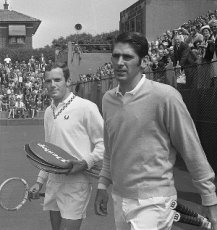1968 Tennis player
 Tennis balls went beyond white—to optic yellow—in 1968. (AP Photo) [Below: Tom Okker and Marty Riessen, in 1968; Wikimedia Commons)
Tennis balls went beyond white—to optic yellow—in 1968. (AP Photo) [Below: Tom Okker and Marty Riessen, in 1968; Wikimedia Commons)
This year marks the 50th anniversary of TENNIS Magazine's founding in 1965. To commemorate the occasion, we'll look back each Thursday at one of the 50 moments that have defined the last half-century in our sport.
Tennis is often described as a “lily white” sport. Before 1968, there was more than a little truth to the accusation.
The clothes that high-level players wore were virtually all white. The idea was originally inspired by cricket, which was played at the same clubs as tennis in Victorian England. The color, or lack thereof, also happened to suit the decorous ladies and gentleman who first played tennis, and who were big believers in never letting anyone see you sweat. For most of the 20th century, Wimbledon didn’t need to have an all-white clothing rule; no one thought of wearing anything else.
During that time, the top players themselves were almost all white. Althea Gibson became the first African-American to win a Grand Slam at the French Open in 1956, and there were a scattering of Latin champions, including Pancho Gonzalez and Mexico’s Rafael Osuna, who won the 1963 U.S. Nationals. But for much of the 20th century, the vast majority of major-title winners were white men and women who hailed from Australia or the United States.
 Finally, even the balls were white. Purity was the image that tennis cultivated; this was a sport, its clothes and balls and general politesse said, that was above the commercial fray. Above the sexual fray as well: When Ted Tinling designed lace panties for Gussie Moran at Wimbledon in 1949, a club official screamed that he had “brought shame and sin” onto the grounds. Tinling wouldn’t return for 20 years.
Finally, even the balls were white. Purity was the image that tennis cultivated; this was a sport, its clothes and balls and general politesse said, that was above the commercial fray. Above the sexual fray as well: When Ted Tinling designed lace panties for Gussie Moran at Wimbledon in 1949, a club official screamed that he had “brought shame and sin” onto the grounds. Tinling wouldn’t return for 20 years.
All of that changed with the start of the Open era; crossing the commercial line meant crossing the color line, too. It was color, in fact, that helped lead the sport into its new age. In 1967, the BBC chose to make the Wimbledon men’s final its first broadcast—of anything—in technicolor. Suddenly, the folks at home could see that the surface was bright green on Centre Court, and they liked it. Broadcasters, and advertisers, began to think the grass might be a little greener in tennis than they had previously believed.


